- Joined
- Oct 9, 2007
- Messages
- 47,572 (7.46/day)
- Location
- Dublin, Ireland
| System Name | RBMK-1000 |
|---|---|
| Processor | AMD Ryzen 7 5700G |
| Motherboard | ASUS ROG Strix B450-E Gaming |
| Cooling | DeepCool Gammax L240 V2 |
| Memory | 2x 8GB G.Skill Sniper X |
| Video Card(s) | Palit GeForce RTX 2080 SUPER GameRock |
| Storage | Western Digital Black NVMe 512GB |
| Display(s) | BenQ 1440p 60 Hz 27-inch |
| Case | Corsair Carbide 100R |
| Audio Device(s) | ASUS SupremeFX S1220A |
| Power Supply | Cooler Master MWE Gold 650W |
| Mouse | ASUS ROG Strix Impact |
| Keyboard | Gamdias Hermes E2 |
| Software | Windows 11 Pro |
AMD today announced its 4th Generation Ryzen 4000G and Ryzen PRO 4000G desktop processors for pre-built OEM desktops. The company also expanded its entry-level Athlon 3000G series and debuted the Athlon PRO 3000G series. The Ryzen 4000G and PRO 4000G mark the Socket AM4 desktop debut of the 7 nm "Renoir" silicon, which combines up to 8 CPU cores based on the "Zen 2" microarchitecture, with a Radeon Vega 8 iGPU. These processors benefit from the 65 W TDP and increased power limits of the desktop platform to dial up CPU- and iGPU engine clock speeds significantly over the Ryzen 4000U and 4000H mobile processors based on the same silicon. The new Athlon 3000G-series and Athlon PRO 3000G-series parts are based on a 12 nm die that has "Zen+" CPU cores.
All of the processor models announced today are OEM-only, meaning that you'll only find them on pre-built consumer- and commercial desktops by the likes of HP, Lenovo, Dell, etc. Not even the system-integrator (SI) channel (eg: Maingear, Origin PC, etc.,) gets these chips. OEMs will pair these processors with motherboards based on the AMD B550 chipset, although the chips are compatible with the X570 chipset, too. The Ryzen PRO 4000G processors are targeted at commercial desktops that are part of large business environments, and launches along with the new AMD PRO565 chipset. Since they are OEM-only, the company did not reveal pricing for any of these chips. They did however mention that for the DIY retail channel, they do plan to update their product stack with processors that have integrated graphics at a later time (without going into specifics of the said time).


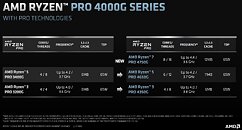
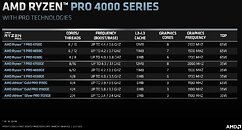
On the consumer side of things, the Ryzen 4000G series consists of 8-core/16-thread Ryzen 7, 6-core/12-thread Ryzen 5, and 4-core/8-thread Ryzen 3 SKUs. The lineup is led by the Ryzen 7 4700G, which is endowed with the full 8-core/16-thread CPU clocked at 3.60 GHz, with 4.40 GHz max boost, all 8 "Vega" iGPU compute units (512 stream processors), and a stellar iGPU engine clock of 2.10 GHz. All this fits into a 65 W TDP envelope. The Ryzen 5 4600G is the mid-tier offering with a 6-core/12-thread CPU clocked at 3.70 GHz with 4.20 GHz boost, 7 CUs enabled (448 stream processors), and 1.90 GHz iGPU engine clock. The value-segment Ryzen 3 4300G packs a 4-core/8-thread CPU clocked at 3.80 GHz, with 4.00 GHz boost frequency, 6 CUs (384 stream processors) enabled, and 1.70 GHz iGPU engine clock. All three chips feature 65 W TDP.
Just like on Picasso, and Renoir Mobile, Renoir desktop supports external graphics cards with a PCI-Express 3.0 x8 interface—you heard right, no PCIe Gen 4. The PCIe subsystem hasn't been updated in any way. For the OEM business this makes sense of course, because AMD expects Renoir prebuilts to come without discrete graphics—that's their selling point. For systems with graphics card, OEMs are expected to use the regular Zen 2 Ryzens.



There are energy-efficient "GE" variants of these consumer chips that have 35 W TDP. The 4700GE is clocked at 3.10 GHz with 4.30 GHz boost and 2.00 GHz iGPU engine clocks; the 4600GE with 3.30 GHz CPU clocks that boost to 4.20 GHz, and 1.90 GHz iGPU engine clocks, and the 4300GE with 3.50 GHz base, 4.00 GHz boost, and 1.70 GHz iGPU engine clocks. These chips will feature aggressive power management to meet the 35 W TDP, performing on par with H/HS-segment mobile processors.
The "Zen 2" cores in all these chips feature 512 KB of dedicated L2 cache, each. The "Renoir" silicon has two quad-core CCXs, each with 4 MB of L3 cache that's shared among the four cores of the CCX. The 4700G/4700GE hence have 12 MB "total cache" (L2+L3 in AMD parlance); the 4600G/4600GE have 11 MB, and the 4300G/4300GE have 6 MB (an entire CCX is disabled).
The Ryzen PRO 4000G series consists of three models, the Ryzen 7 PRO 4750G, the PRO 4650G, and the PRO 4350G. The three feature identical clock speeds and features to the 4700G, 4600G, and 4300G, respectively; but top them with the AMD PRO feature-set that rivals Intel vPro. The AMD PRO feature-set includes AMD PRO Security, a multi-layered security system, including full memory encryption; AMD PRO Management (rivals Intel Active Management Technology); and AMD PRO Business support ecosystem rivaling AMD vPro SIPP.
New additions to the consumer-segment Athlon 3000G series includes the new Athlon Gold and Athlon Silver 3000G-series processor family. These chips are based on the 12 nm "Picasso" silicon that features up to four "Zen+" CPU cores. The Athlon Gold 3150 offers a 4-core/4-thread CPU clocked at 3.90 GHz (no boost), 6 MB of total cache, and 65 W TDP. Its energy-efficient twin, the Athlon Gold 3150GE, ticks at 3.80 GHz, with a much slimmer 35 W TDP. The Athlon Silver 3050GE is a 2-core/4-thread chip with 5 MB total cache, and 3.50 GHz CPU clocks. There are PRO variants of the three chips, too.
The Slide Deck follows.



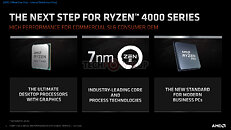

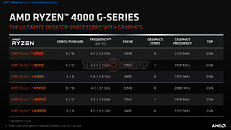


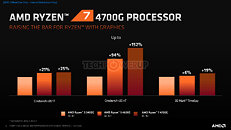
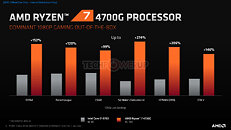

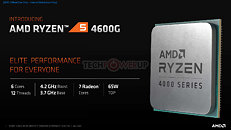
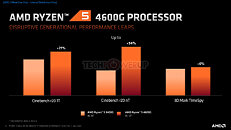

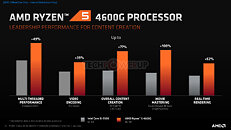



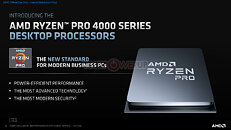

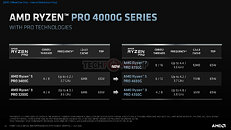


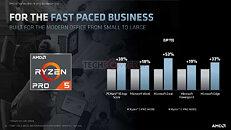
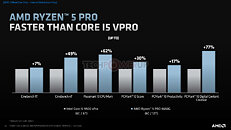

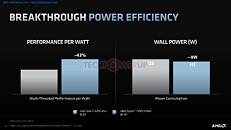






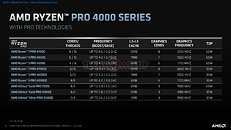

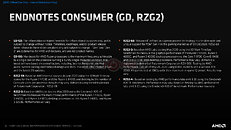



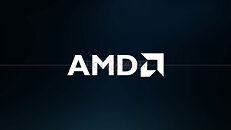








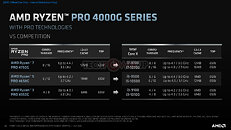



View at TechPowerUp Main Site
All of the processor models announced today are OEM-only, meaning that you'll only find them on pre-built consumer- and commercial desktops by the likes of HP, Lenovo, Dell, etc. Not even the system-integrator (SI) channel (eg: Maingear, Origin PC, etc.,) gets these chips. OEMs will pair these processors with motherboards based on the AMD B550 chipset, although the chips are compatible with the X570 chipset, too. The Ryzen PRO 4000G processors are targeted at commercial desktops that are part of large business environments, and launches along with the new AMD PRO565 chipset. Since they are OEM-only, the company did not reveal pricing for any of these chips. They did however mention that for the DIY retail channel, they do plan to update their product stack with processors that have integrated graphics at a later time (without going into specifics of the said time).




On the consumer side of things, the Ryzen 4000G series consists of 8-core/16-thread Ryzen 7, 6-core/12-thread Ryzen 5, and 4-core/8-thread Ryzen 3 SKUs. The lineup is led by the Ryzen 7 4700G, which is endowed with the full 8-core/16-thread CPU clocked at 3.60 GHz, with 4.40 GHz max boost, all 8 "Vega" iGPU compute units (512 stream processors), and a stellar iGPU engine clock of 2.10 GHz. All this fits into a 65 W TDP envelope. The Ryzen 5 4600G is the mid-tier offering with a 6-core/12-thread CPU clocked at 3.70 GHz with 4.20 GHz boost, 7 CUs enabled (448 stream processors), and 1.90 GHz iGPU engine clock. The value-segment Ryzen 3 4300G packs a 4-core/8-thread CPU clocked at 3.80 GHz, with 4.00 GHz boost frequency, 6 CUs (384 stream processors) enabled, and 1.70 GHz iGPU engine clock. All three chips feature 65 W TDP.
Just like on Picasso, and Renoir Mobile, Renoir desktop supports external graphics cards with a PCI-Express 3.0 x8 interface—you heard right, no PCIe Gen 4. The PCIe subsystem hasn't been updated in any way. For the OEM business this makes sense of course, because AMD expects Renoir prebuilts to come without discrete graphics—that's their selling point. For systems with graphics card, OEMs are expected to use the regular Zen 2 Ryzens.



There are energy-efficient "GE" variants of these consumer chips that have 35 W TDP. The 4700GE is clocked at 3.10 GHz with 4.30 GHz boost and 2.00 GHz iGPU engine clocks; the 4600GE with 3.30 GHz CPU clocks that boost to 4.20 GHz, and 1.90 GHz iGPU engine clocks, and the 4300GE with 3.50 GHz base, 4.00 GHz boost, and 1.70 GHz iGPU engine clocks. These chips will feature aggressive power management to meet the 35 W TDP, performing on par with H/HS-segment mobile processors.
The "Zen 2" cores in all these chips feature 512 KB of dedicated L2 cache, each. The "Renoir" silicon has two quad-core CCXs, each with 4 MB of L3 cache that's shared among the four cores of the CCX. The 4700G/4700GE hence have 12 MB "total cache" (L2+L3 in AMD parlance); the 4600G/4600GE have 11 MB, and the 4300G/4300GE have 6 MB (an entire CCX is disabled).
The Ryzen PRO 4000G series consists of three models, the Ryzen 7 PRO 4750G, the PRO 4650G, and the PRO 4350G. The three feature identical clock speeds and features to the 4700G, 4600G, and 4300G, respectively; but top them with the AMD PRO feature-set that rivals Intel vPro. The AMD PRO feature-set includes AMD PRO Security, a multi-layered security system, including full memory encryption; AMD PRO Management (rivals Intel Active Management Technology); and AMD PRO Business support ecosystem rivaling AMD vPro SIPP.
New additions to the consumer-segment Athlon 3000G series includes the new Athlon Gold and Athlon Silver 3000G-series processor family. These chips are based on the 12 nm "Picasso" silicon that features up to four "Zen+" CPU cores. The Athlon Gold 3150 offers a 4-core/4-thread CPU clocked at 3.90 GHz (no boost), 6 MB of total cache, and 65 W TDP. Its energy-efficient twin, the Athlon Gold 3150GE, ticks at 3.80 GHz, with a much slimmer 35 W TDP. The Athlon Silver 3050GE is a 2-core/4-thread chip with 5 MB total cache, and 3.50 GHz CPU clocks. There are PRO variants of the three chips, too.
The Slide Deck follows.




















































View at TechPowerUp Main Site







 I've heard that totally pointless argument for months now.
I've heard that totally pointless argument for months now.





